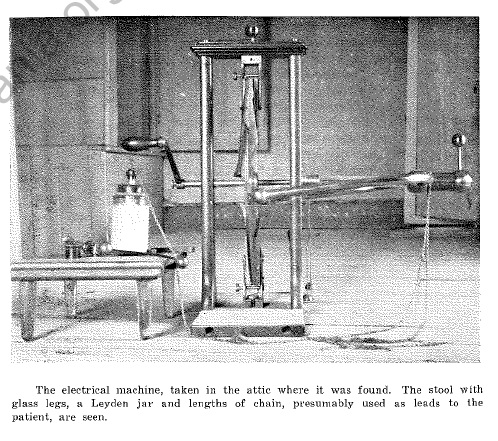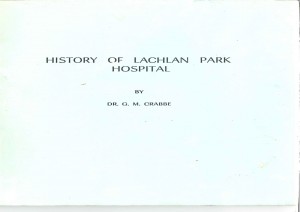 The “Electrical Machine” found in the attic in the old Officers bedroom is contained in the history of Lachlan Park book by Dr G.M Crabbe. This book is a review of file notes from the early to mid 1800’s and beyond. It is able to shine a light on treatments and practices within mental health services in early Tasmania. The extensive use of Convicts and ex-convicts as support staff appeared as a common practice and also an ongoing problem according to the book, “In contrast to this, those in charge did seem to have the patients interests at heart and did their best to care for them. They were very handicapped by having the hospital staffed by convicts and ex-convicts, the Medical Officers, Matron and Headkeeper being the only “Free”.
The “Electrical Machine” found in the attic in the old Officers bedroom is contained in the history of Lachlan Park book by Dr G.M Crabbe. This book is a review of file notes from the early to mid 1800’s and beyond. It is able to shine a light on treatments and practices within mental health services in early Tasmania. The extensive use of Convicts and ex-convicts as support staff appeared as a common practice and also an ongoing problem according to the book, “In contrast to this, those in charge did seem to have the patients interests at heart and did their best to care for them. They were very handicapped by having the hospital staffed by convicts and ex-convicts, the Medical Officers, Matron and Headkeeper being the only “Free”.
There is also a lot mentioned about Electricity being used as far back as 1851, “strong galvanic current” however a clear difference was the time that the electricity was used for a patient in that time and what would be used today with modern ECT. The Galvanic battery would be able to deliver long doses of electricity to the patient and there are clear records indicating that the use of the electricity was used verbally as a threat instead of a treatment. Reasons for long electrical treatment could be, not eating, being idle, being violent, refusal to work and delusions. Dr Grabbe also questions whether the electric shock or galvanic battery were also delivered through hip or foot baths, the file notes are unclear.
Treatments involving cold bath or shower, hip bath are also mentioned in the patient notes that Dr Crabbe reveals.
The treatments given were the usual ones in those days. Emetics and purgatives, especially on admission, were used frequently; heads were shaved; setons were inserted in the neck, great satisfaction being expressed when they discharged freely; heads were blistered; disturbed patients were given cold showers, which frequently did anything but quieten them; mercury was given in full doses, till a stomatitis was produced, but this was not considered an indication to discontinue the administration. Sedatives were not much favoured, the only one in use being opium, but in spite of its being effective, it was not used very often.
There is clear history of the Barrel tunnel being put in, to stop issues and complaints from downstream residents.
Dr Crabbe clearly had an interesting in the treatments used and proposed in the early history of Willow Court and a number of terms used throughout the book are clearly that of an educated medical practitioner with a keen sense of gathering this history before his own death, most of the research was done while he coped with his own health issues.
